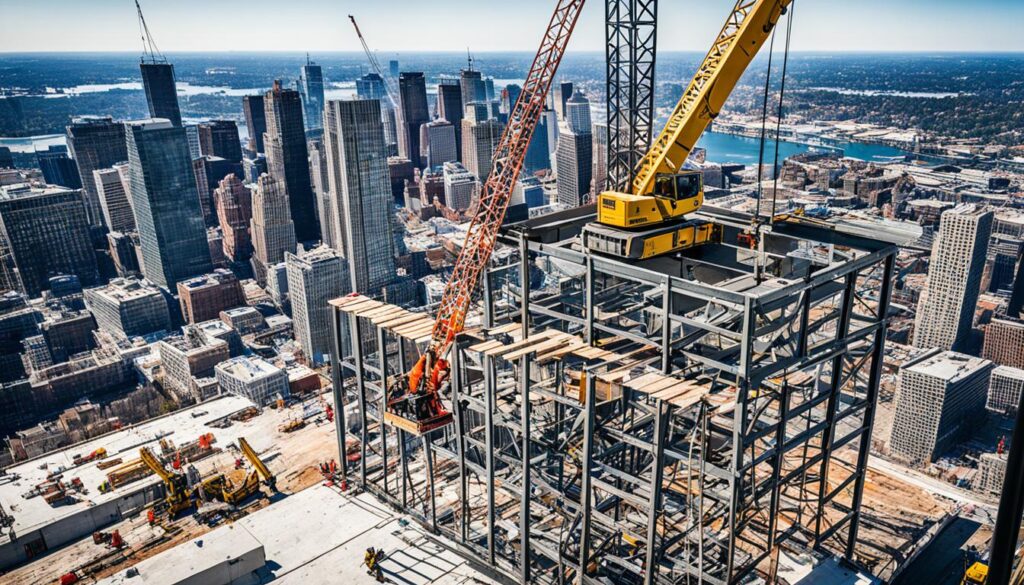Three Storey Building Height
Three Storey Building Height : In the world of building, the height of structures is key. It affects the look and use of a city.

Three Storey Building Height : In the world of building, the height of structures is key. It affects the look and use of a city. The three-storey building is a top choice for both work and living spaces. This piece will look at the design, building, and rules of three-storey buildings in the U.S.
Zoning laws, building codes, and engineering set the max height for three-storey buildings. City planners and local officials make rules to keep these buildings in line with the area’s look and feel. Building codes, like how strong the building must be, keeping safe from fires, and being easy to get into, shape the design and strength of three-storey buildings.

Key Takeaways
- Knowing the rules about three-storey building height is key for building projects.
- Structural engineering, like how strong the building must be and what materials to use, is vital for three-storey buildings.
- Designing the building, including the layout and how it looks outside, is important for its use and look.
- Getting permits for building requires careful following of local rules.
- Things like the land, city planning goals, and what the market wants can affect three-storey building plans.
Maximum Building Height: Exploring the Zoning Laws and Building Codes
In urban development, the height of buildings is key. Zoning laws and building codes set limits. They shape city skylines and keep our buildings safe and useful.
Urban Planning and Zoning Regulations
Zoning laws set rules for land use and building height. They help with orderly growth and keep neighborhoods unique. They also ensure we have enough sunlight, good traffic flow, and access to emergency services.
Building height limits vary by region. Some places let buildings get very tall. Others keep them lower to protect the area’s look or match nearby buildings.
Building Code Requirements for Three-Storey Structures
Building three-storey buildings also means following building codes. These rules cover safety, performance, and more. They make sure buildings are strong, safe, accessible, and use less energy.
- Structural design: Codes give guidelines for how strong buildings must be and what materials to use.
- Fire safety: Buildings need sprinkler systems, emergency exits, and fire-safe materials.
- Accessibility: Codes make sure three-storey buildings are easy for everyone to get around in.
- Energy efficiency: Buildings must save energy with insulation and efficient heating and cooling systems.
Knowing zoning laws and building codes is key for developers and architects. It helps them build safely and in line with community goals.
Structural Engineering for Three Storey Building Height
Building three-storey structures requires careful planning in structural engineering. It ensures the buildings are safe, stable, and last a long time. Architects and engineers must think about how to support the extra weight of the upper floors. They choose the right materials and design a system that can handle the stress.
Supporting the extra floors is a big challenge. Load-bearing walls, columns, and foundations need to take more weight and pressure. This is much more than what single-story or two-story buildings need.
Choosing the right materials is key. Reinforced concrete, structural steel, and engineered wood are common choices. Engineers look at each material’s strengths and costs to pick the best one for the job.
Structural engineers also think about forces that push from the side, like wind or earthquakes. The building must be strong against these forces to keep everyone safe and the structure lasting.
Building three-storey buildings is complex. It involves understanding construction, design, and many other factors. By thinking about these, engineers make sure the buildings are safe, affordable, and look good.
Three Storey Building Height: Architectural Design Considerations
Designing a three-storey building requires careful thought on both functionality and looks. Architects must plan the layout and exterior to make it a success. This includes making the most of each floor and creating a welcoming look outside.
Optimizing Floor Plans and Space Utilization
Maximizing space is key in three-storey buildings. Architects plan the layout to use every inch well. They make sure each floor works well for its purpose. This means using open layouts, smart stairwell placement, and easy traffic flow.
Details in the floor plans also matter a lot. They help make the building useful and look good. Things like plenty of storage, rooms that serve many purposes, and smart use of height make a building both useful and nice to look at.
Aesthetic Appeal and Exterior Design
The look of a three-storey building’s outside is very important. Architects must make it both useful and eye-catching. They aim to match the building with its surroundings and draw in people.
Choosing materials, where windows go, the shape of the roof, and lighting can make a building look great. With careful planning, architects can make a building that looks amazing and works well.

For a three-storey building, finding the right balance between use and beauty is key. By planning the layout well, using space wisely, and making the outside look good, architects can create buildings that are both useful and stunning.
The Permitting Process for Multistory Construction
Building a three-storey building means going through a detailed permitting process. This ensures it meets local rules and building codes. It’s key to know what permits and documents you need for a successful project.
Building Permit Requirements and Documentation
Before starting a three-storey project, builders must get the right permits. They need to submit lots of documents, like:
- Detailed architectural drawings and plans
- Structural engineering calculations and specs
- Energy efficiency and sustainability assessments
- Proof of zoning and land-use compliance
- Construction timeline and project schedule
- Liability insurance and worker’s comp coverage
Requirements can change based on where you are, but the main goal is to make sure the project is safe and meets building codes. This ensures the multistory construction meets all the rules.
After submitting the permit application, local authorities check it for feasibility and compliance. This can take weeks or months, depending on the project’s complexity and the office’s workload.
“The permitting process is a critical step in the construction permits for any multistory building, as it ensures the safety and integrity of the structure while also aligning with local building documentation requirements.”
Going through the permitting process takes time and attention to detail. But it’s vital for a successful three-storey building permits project. Understanding and following the requirements helps builders get approval faster and start building sooner.

Factors Affecting Three Storey Building Height
Building three-storey structures involves many factors that affect their height. These include local zoning laws and the materials used for construction. Each of these factors is crucial in determining the building’s final height.
Local zoning laws and building codes are key in setting the maximum height for buildings. These rules are made by local governments. They ensure that buildings fit the area’s use and needs.
The choice of construction materials also affects a building’s height. Some materials like steel or reinforced concrete let for taller buildings. The strength and capacity of materials to carry weight are important for the building’s height.
Site-specific considerations like the land’s shape, soil, and how close it is to other buildings also matter. These can affect the building’s height. For example, the land’s slope or soil stability might limit how tall a building can be.
Finally, aesthetic and design preferences can also influence a building’s height. Architects might choose a certain style or design that requires a specific height. This might be even if the building could be taller according to other rules or materials.
Knowing these factors is key for those designing and building three-storey buildings. They need to consider the needs of the people using the building, the local environment, and the rules in place.
| Factor | Impact on Three Storey Building Height |
|---|---|
| Local Zoning Regulations | Set the highest allowed height for buildings in an area |
| Construction Materials | The strength and capacity of materials affect the maximum height |
| Site Considerations | The land’s shape, soil, and closeness to other buildings can limit height |
| Aesthetic and Design Preferences | Design choices might require certain heights for the building |
By looking at these factors, architects, builders, and local officials can create three-storey buildings. These buildings should serve the community well, follow the rules, and be safe and strong.
“Successful three-storey building design requires a delicate balance between meeting functional needs, complying with local regulations, and achieving aesthetic appeal.”
Challenges and Considerations in Three Storey Building Design
Designing a three-storey building is a complex task. It requires careful planning and execution. Architects and engineers must think about structural strength and code rules. Each step of the design process is crucial for a successful project.
Structural Integrity: Balancing Load-Bearing Demands
Ensuring the building stands strong is a big concern. Architects and engineers look at the building’s weight and forces like wind and earthquakes. They make sure the foundation, walls, and floors are strong to keep everyone safe.
Building codes and regulations are many and varied. Designers must keep up with changes in fire safety, accessibility, and energy efficiency. Working closely with local authorities helps get through the permitting process smoothly.
Project Management: Coordinating Complex Logistics
Building a three-storey building is a big job. It involves getting materials, coordinating workers, and managing the site safely. Good project management is key to finish on time and within budget. Planning, scheduling, and clear communication are vital.
| Challenge | Consideration |
|---|---|
| Structural Integrity | Analyze load-bearing requirements, reinforce foundation, walls, and floors |
| Code Compliance | Stay up-to-date with building codes, collaborate with local authorities |
| Project Management | Coordinate logistics, optimize scheduling and resource allocation |
By tackling these challenges, architects, engineers, and managers can overcome the hurdles of three-storey building design. They can create safe, quality buildings that follow the rules.
“Designing a three-storey building requires a delicate balance between structural integrity, code compliance, and effective project management. It’s a true test of an architect’s and engineer’s skills.”
Trends and Future Developments in Three Storey Building Height
The world of architecture is always changing. Trends and future changes in three-storey building height are no different. They are being shaped by sustainable design, new technology, and the need for more space in cities.
Sustainable design is leading the way in building construction. Architects and engineers use green technologies, energy-saving materials, and smart water systems in three-storey buildings. This approach helps the environment and makes these buildings more cost-effective over time.
Technology is also changing the future of three-storey buildings. Tools like building information modeling (BIM) software, automated construction methods, and smart building tech are making building easier and better. These tools improve efficiency, allow for more design options, increase safety, and cut down on costs.
FAQ
What is the typical height of a three-story building?
A three-story building usually stands between 30 to 45 feet tall. This height can change due to ceiling heights, building codes, and local laws.
What are the key building code requirements for three-story structures?
Building codes for three-story buildings focus on safety and efficiency. They cover structural strength, fire safety, accessibility, and energy use. This includes rules for load-bearing walls, staircases, exits, and insulation.
How do zoning laws impact the maximum height of three-story buildings?
Zoning laws set limits on building heights, including for three-story buildings. These limits depend on the area, building use, and nearby development.
What structural engineering considerations are important for three-story buildings?
Important structural engineering aspects include load-bearing walls and choosing the right materials. Wind loads, seismic activity, and occupancy also affect the design.
How can the architectural design of three-story buildings maximize space and aesthetics?
Good design focuses on smart floor plans and efficient use of space. It also aims for a pleasing look. Open layouts and design elements that fit the area help achieve this.
What is the permitting process for constructing a three-story building?
Getting permits for a three-story building means getting local approvals and meeting codes. You’ll need to submit detailed plans, structural calculations, and show you follow zoning and safety rules.
What factors can influence the maximum height of a three-story building?
The height of a three-story building can change based on zoning laws, building codes, site conditions, materials, and the building’s purpose.
What are some of the key challenges in designing and constructing three-story buildings?
Challenges include ensuring the building is strong, safe, and accessible. Managing the construction process and coordinating with different professionals are also tough.
What emerging trends are shaping the future of three-story building design?
New trends include sustainable design, advanced materials, and innovative space-saving ideas. These help with urban density and efficient land use.




